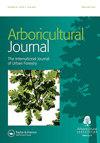Editorial: climate, extreme weather, and the need for community engagement with urban tree futures
Q3 Agricultural and Biological Sciences
引用次数: 0
Abstract
Long-standing climate changes are triggering more extreme weather events which are greater in intensity but also more frequent in occurrence. Whilst trees, particularly in urban and peri-urban areas, help moderate extreme weather and may even contribute to at least a slowing of some adverse changes, they are in turn threatened by storms, droughts, and floods. Responding to these pressures necessitates new approaches, and techniques to both reduce and sometimes to repair damage, and this is where arboricultural science and good practice come to the fore. Additionally, in order to improve best practice and to provide dissemination of novel ideas, and importantly to test them, communication is the key. Furthermore, this is increasingly necessary on a global scale, and hopefully, the Arboricultural Journal plays a vital role in this. However, the development of effective strategies to address the coming challenges for urban trees and especially for established trees which increasingly become urbanised and stressed, involves a host of variable stakeholders including NGOs. Moreover, with cash-strapped local authorities, the work of non-governmental organisations (NGOs) and of forest volunteers and tree wardens becomes more vital. These are all matters considered by the selection of papers for this issue of the Arboricultural Journal. Elton et al. (2023) have taken the eastern United States as a case-study region to examine urban forestry non-governmental organisations. They showed the importance of NGOs, of volunteers, and of strategic partnerships in delivering urban forestry, and especially in matters of awareness and communication to a wider public. Activities where this was the case included major tree-planting projects and in celebratory and educational events. In a paper that is relevant to this discussion, Danquah (2023), considered the perceptions of trees in urban areas held by landlords and owners of businesses. Concerns included root-damage to buildings and slippery surfaces caused by both fallen leaves and dropped fruit. Positive aspects of urban trees were felt to be the provision of edible fruits and nuts, improved health conditions, shade, and oxygen production by trees. Furthermore, in urban areas, protection from wind was important. It is useful to gain insight into attitudes and perceptions held by key stakeholders if effective, long-term strategies are to be implemented. As noted earlier, with changing climate, we are witnessing more extreme weather events, and these bring damage and risk. Potentially, in an urban area, the impacts of storm damage or other related impacts may decrease local resilience to long-term changes. Addressing responses to storm-damaged trees is discussed for the case-study area of New Jersey State (USA) by Greene and Greene (2023). They examined the damage to trees in storm-prone areas and considered possible actions to recover, remediate, or repair stormdamaged specimens. The approach and the ideas presented raise further questions about our responses to catastrophic events and the damage, perhaps, of short-term, knee-jerk Arboricultural Journal 2023, VOL. 45, NO. 3, 177–178 https://doi.org/10.1080/03071375.2023.2235941社论:气候、极端天气以及社区参与城市树木未来的需求
长期的气候变化正在引发更多的极端天气事件,这些事件的强度更大,但发生的频率也更频繁。虽然树木,特别是城市和城郊地区的树木,有助于缓和极端天气,甚至可能至少有助于减缓一些不利的变化,但它们反过来又受到风暴、干旱和洪水的威胁。应对这些压力需要新的方法和技术来减少和有时修复损害,这就是树木科学和良好实践脱颖而出的地方。此外,为了改进最佳实践,传播新颖的想法,重要的是测试它们,沟通是关键。此外,这在全球范围内越来越有必要,希望《树木学杂志》在这方面发挥至关重要的作用。然而,制定有效的战略来应对城市树木面临的挑战,特别是对日益城市化和压力的现有树木,涉及包括非政府组织在内的许多不同的利益相关者。此外,由于地方政府资金紧张,非政府组织(ngo)、森林志愿者和树木管理员的工作变得更加重要。这些都是本期《树木学杂志》的论文选择所考虑的问题。Elton et al.(2023)以美国东部为个案研究区域考察城市林业非政府组织。它们显示了非政府组织、志愿者和战略伙伴关系在提供城市林业方面的重要性,特别是在向更广泛的公众宣传和沟通方面的重要性。这方面的活动包括大型植树项目以及庆祝和教育活动。在一篇与本讨论相关的论文中,Danquah(2023)考虑了房东和企业所有者对城市地区树木的看法。人们担心的是,落叶和掉落的果实会对建筑物的根部造成损害,并导致地面湿滑。城市树木的积极方面被认为是提供可食用的水果和坚果,改善健康条件,树荫和树木的氧气生产。此外,在城市地区,防风是很重要的。如果要实施有效的长期战略,了解关键利益攸关方持有的态度和看法是有用的。如前所述,随着气候变化,我们正在目睹更多的极端天气事件,这些事件带来了破坏和风险。在城市地区,风暴破坏或其他相关影响的影响可能会降低当地对长期变化的适应能力。Greene和Greene(2023)针对美国新泽西州的案例研究区域讨论了应对风暴破坏树木的方法。他们检查了风暴易发地区的树木受损情况,并考虑采取可能的措施来恢复、修复或修复被风暴破坏的树木。提出的方法和想法进一步提出了关于我们对灾难性事件和损害的反应的问题,也许是短期的,下意识的树木学杂志2023,VOL. 45, NO。3,177 - 178 https://doi.org/10.1080/03071375.2023.2235941
本文章由计算机程序翻译,如有差异,请以英文原文为准。
求助全文
约1分钟内获得全文
求助全文
来源期刊

Arboricultural Journal
Agricultural and Biological Sciences-Agronomy and Crop Science
CiteScore
2.40
自引率
0.00%
发文量
28
期刊介绍:
The Arboricultural Journal is published and issued free to members* of the Arboricultural Association. It contains valuable technical, research and scientific information about all aspects of arboriculture.
 求助内容:
求助内容: 应助结果提醒方式:
应助结果提醒方式:


